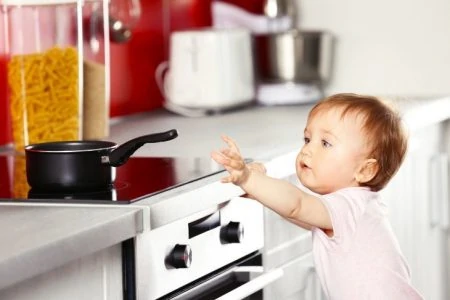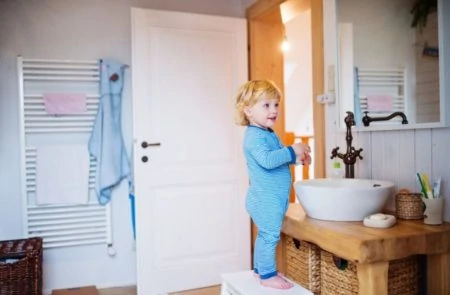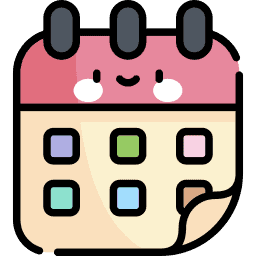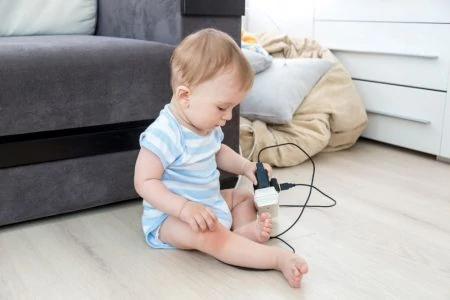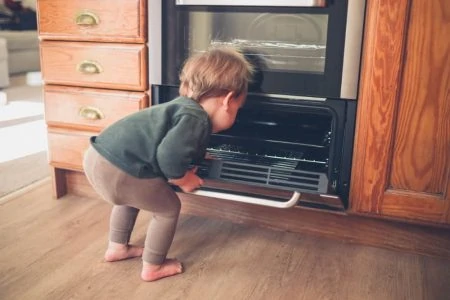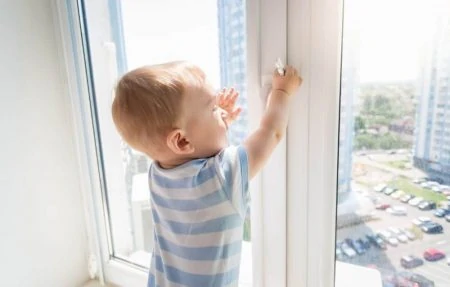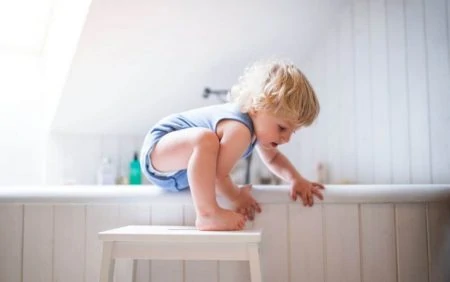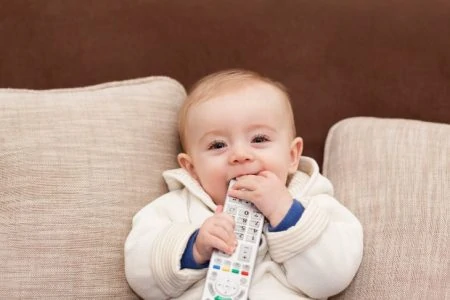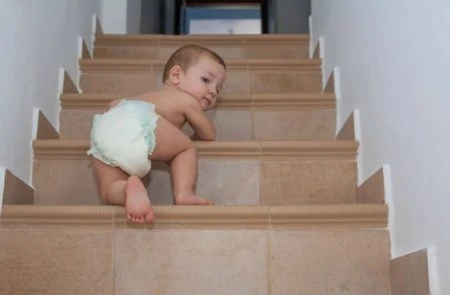Bringing a new baby home changes your perspective on everything. Suddenly, bookshelves look like ladders, outlets seem like targets, and coffee tables appear to be made of jagged rocks.
It is normal to feel anxious. Every 24 minutes, a falling TV or tipping furniture sends a child to the emergency room. However, preparation beats panic every time.
In this guide, we will walk you through a practical room-by-room checklist to babyproof your home and prevent unwanted accidents.
Babyproofing Checklist
Download Babyproof Checklist PDF
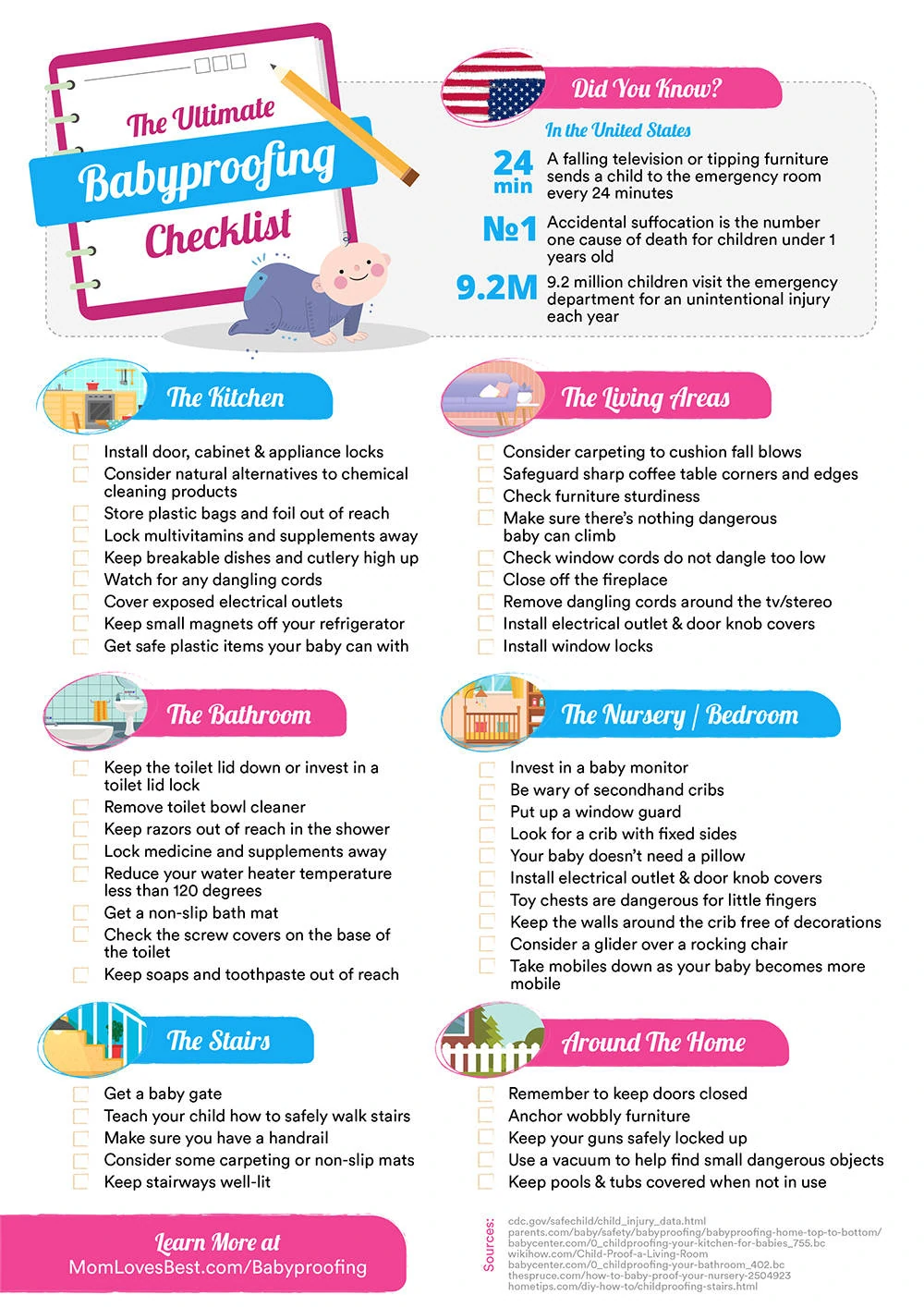
Common Injuries In the Home
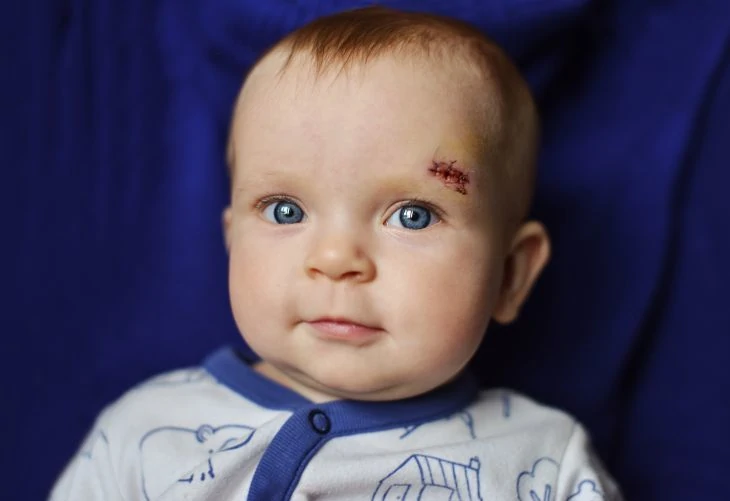
Babies are innocent and curious. They do not look for trouble, but they learn by exploring the world around them. Since they spend most of their time at home, that is where most accidents happen.
Here are the most common injuries babies suffer at home.
- Falling and tripping: Whether they are furniture cruising and lose balance, or fall from a changing table, gravity is a real threat. Fortunately, babies are resilient. Most falls under two feet generally do not cause serious injury, but vigilance is key.
- Burns: Children under two years old are most often burned by scalded food or liquid in the kitchen (1). This happens when parents cook while holding a baby, or when toddlers pull hot pans off the stove.
- Poisoning: Cleaning products in low cabinets are sitting ducks for crawling babies. It only takes a minute for a child to unscrew a cap and ingest harmful chemicals. U.S. Poison Control Centers estimate about 41.9 poisoning incidents occur for every 1,000 children under 6 years old (2).
- Drowning: Drowning is a major threat, and it often happens in the bathtub (3). A parent might look away for just a moment to grab a towel, which is enough time for an accident to occur.
- Choking: Babies explore with their mouths. They find tiny items on the floor that parents dropped or missed. Sadly, a child in the U.S. dies from choking every five days (4).
- Furniture tipping over: Bookshelves and dressers look like great climbing structures to a toddler. If these pieces are not anchored to the wall, they can tip over and cause crushing injuries or death.
- Suffocation: Unsafe sleeping conditions are dangerous. Sleeping in an adult bed or a crib with heavy blankets and pillows leads to accidental suffocation, which is a leading cause of death for infants under one year old (5).
- Electrocution: Electrical outlets are at the perfect eye-level for crawling babies. They may try to lick them or stick metal objects inside. Approximately 100 kids die every year from electrocution (6).
Baby Proofing the Kitchen
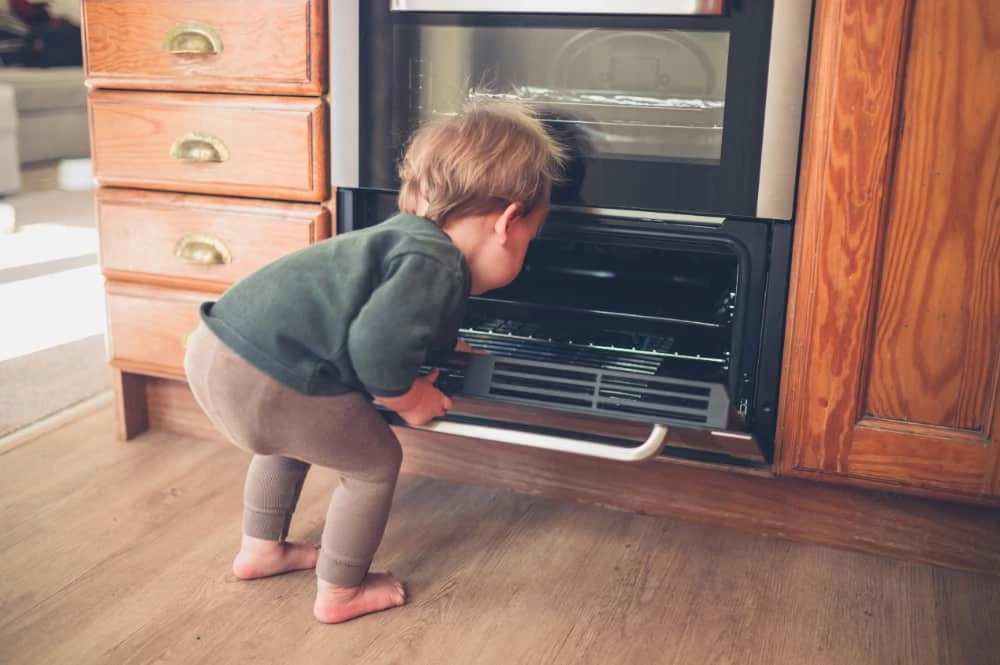
The kitchen is the heart of the home, but it is also a minefield for babies. Burns, cuts, and poisoning are significant risks here.
Use this checklist to ensure your kitchen passes the safety inspection.
- Limit kitchen time: It is hard to keep a baby safe while you are cooking or cleaning. Place your baby in a contained area like a pack ‘n play or a baby swing just outside the kitchen so you can see them without them being underfoot.
- Install safety latches: These are essential for lower cabinets holding cleaning supplies. If your baby figures out the latch (they are smart!), move the dangerous chemicals to a high upper cabinet immediately.
Pro Tip
Alex Lund from SafetyNook recommends “catch and hook” style latches. They are stronger than magnetic locks, which can fail, and they don’t rely on adhesives that ruin your cabinet finish. - Secure the stove knobs: Toddlers love to reach up and turn knobs. Use stove knob covers or remove the knobs entirely when you aren’t cooking. Always cook on the back burners and turn pot handles inward.
- Switch to safer cleaners: Reduce the risk of chemical burns by using safer alternatives like baking soda and vinegar. However, remember that even “natural” products can be toxic in large doses, so keep them locked up too.
- Store plastic bags high up: Reuseable grocery bags and plastic store bags are suffocation hazards. Tie them in a knot and store them well out of reach.
- Watch out for foil boxes: The serrated cutting edge on a box of aluminum foil or plastic wrap is razor-sharp. Keep these in a locked drawer.
- Get a medication lockbox: If you keep meds in the kitchen, use a lockbox. Kids are observant; ensure they never see where you hide the key.
- Treat vitamins like medicine: Iron overdose is a leading cause of poisoning deaths in children (7). Lock away your multivitamins just like you would prescription drugs.
- Move breakables up: If a baby can grab a glass plate or ceramic mug, they will. Move fragile items to upper shelves to prevent cuts from broken glass.
- Secure the knives: Keep knives in a high drawer with a latch, not in a butcher block on the counter where a toddler could reach up and pull them down.
- Shorten dangling cords: A cord hanging from a toaster or blender looks like a pull-toy to a baby. If they yank it, heavy appliances can crash down on their heads. Use cord winders to keep them flush against the wall.
- Remove refrigerator magnets: Small magnets are major choking hazards. If swallowed, high-powered magnets can attract each other through intestinal walls, causing severe damage (8). Remove them until your child is older.
- Create a “Yes” drawer: Distract your baby from the dangerous cabinets by giving them one safe drawer. Fill it with plastic bowls, wooden spoons, and Tupperware they can bang around safely.
Baby Proofing the Living Areas
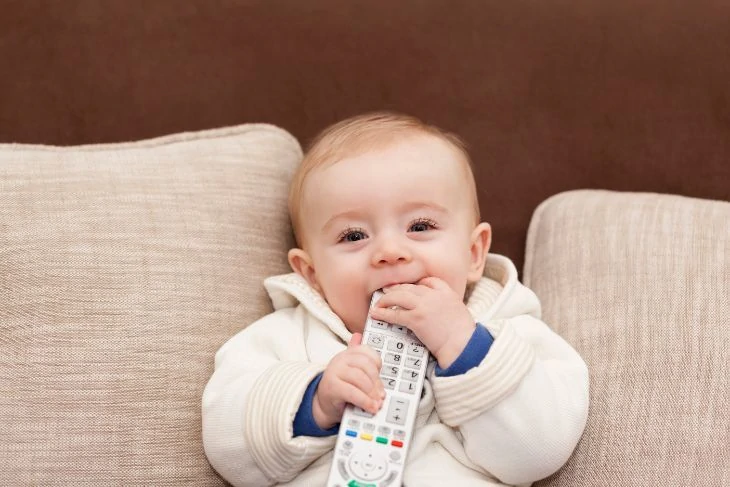
The living room is where the action happens. It is a high-traffic zone where falls and falling objects are the biggest concerns.
Here are ideas on how to babyproof the living room so your little one can explore safely.
- Cushion the floor: If you have hardwood, consider adding a large, thick area rug. A soft landing pad saves a lot of tears when your baby is learning to walk and taking frequent tumbles.
- Address the coffee table: Sharp corners on low tables are perfect targets for a toddler’s forehead. Use corner guards to soften the edges, or swap the table for a soft storage ottoman.
- Get down on their level: Crawl around on your hands and knees. This gives you a baby’s-eye view of hazards you might miss from above, like coins under the sofa or staples in the carpet.
- Anchor the TV and furniture: This is non-negotiable. Flat-screen TVs are top-heavy and easily tipped. Mount your TV to the wall or use heavy-duty safety straps. Anchor bookshelves and dressers to the studs in the wall.
- Secure remote controls: Remotes often contain button batteries. If swallowed, these batteries burn through tissue in as little as two hours. Tape the battery compartment shut or keep remotes totally out of reach.
- Eliminate window cord hazards: Dangling cords from blinds are a strangulation risk. Install cleats to wrap cords high up, or switch to cordless window treatments (9).
- Fireplace safety: Install a heat-resistant gate around the hearth. The glass doors on gas fireplaces get hot enough to cause third-degree burns in seconds. Keep matches and tools locked away.
- Manage the cables: Use cable concealers or raceways to hide wires for the TV and computer. Use outlet covers on every unused plug socket to prevent finger-poking.
- Cover power strips: Power strips are fascinating to babies because of the lights and switches. Use a power strip cover to prevent your child from unplugging items or playing with the sockets.
- Avoid extension cords: These are tripping hazards and chewing hazards. If you must use one, tape it down securely or run it behind heavy furniture.
Baby Proofing the Bathroom
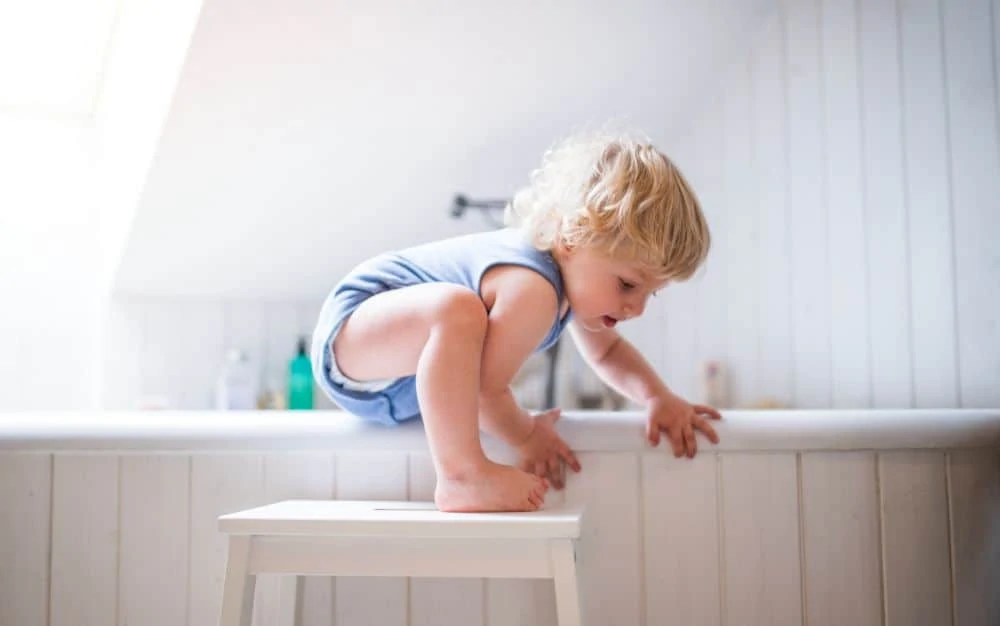
The bathroom is a functional room for adults, but a water park of danger for babies. Drowning and slips are the primary risks here.
Keep your baby safe in the bathroom with these steps.
- Hide the hot tools: Curling irons and straighteners stay hot long after they are unplugged. A hanging cord is an invitation to pull the hot tool down onto a face or arm. Store them immediately after use in a heat-proof pouch.
- Lock the toilet lid: Toddlers are top-heavy. If they lean into a toilet to play with the water, they can fall in and drown. Install a toilet lid lock to keep it shut.
- Skip the bowl tablets: Avoid drop-in toilet bowl cleaners. They turn the water blue, which looks like a drink to a child. The chemicals are highly toxic if ingested (10).
- Remove razors: A razor left on the side of the tub looks like a colorful toy. Keep razors in a high cabinet or on a high shelf in the shower caddy.
- Lock the medicine cabinet: Even if your meds are high up, resourceful toddlers can climb. A childproof lock on the medicine cabinet is mandatory.
- Adjust the water heater: Set your home’s water heater to 120 degrees Fahrenheit (49 degrees Celsius) or lower. A baby’s skin is thinner than yours and burns much faster. Test the water with your elbow before every bath.
- Never leave them alone: There is no safe amount of time to leave a baby in the bath. Not even for a second. If the doorbell rings, take the baby with you.
- Secure toilet bolt caps: The plastic caps at the base of the toilet pop off easily and are a perfect size to choke a child. If they are loose, use a dab of silicone to secure them.
- Elevate the toothpaste: Fluoride toothpaste can cause vomiting if swallowed in large amounts (11). Keep it in a drawer with a latch.
- Use non-slip mats: Bathtubs are slippery. Use a non-slip rubber mat inside the tub and a rug with a grip backing on the floor outside the tub to prevent falls.
- Clean bath toys regularly: Squirting bath toys are breeding grounds for black mold. Squeeze them out completely after every bath, or plug the holes with hot glue so water cannot get inside.
- Unplug appliances: Keep hairdryers and radios away from the water. Unplug them and store them in a cabinet when not in use to prevent electrocution risks.
Baby Proofing the Nursery
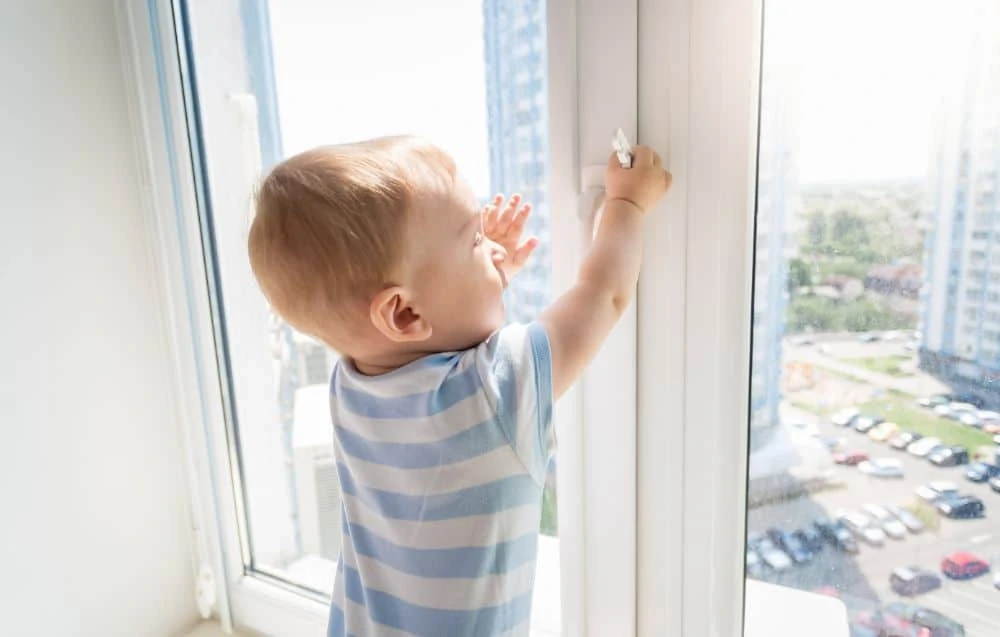
You want the nursery to be a sanctuary. However, safety trumps aesthetics. The main goal here is creating a safe sleep environment.
Here is what you need to look out for in the nursery.
- Place the monitor carefully: A baby monitor is a great tool, but the cord is a strangulation hazard. Mount the camera on the wall or place it on a shelf at least three feet away from the crib.
- Check vintage cribs: Hand-me-downs are sentimental, but older cribs may have slats that are too wide (trapping heads) or contain lead paint. Ensure any crib meets current CPSC safety standards.
Old cribs may also have too wide slats. Crib slats should be closer than 2 5/8th inches or 6 centimeters (less than the width of a soda can). Widely placed slats are a risk for the baby getting head stuck between the slats.Editor's Note:
Dr. Pierrette Mimi Poinsett, MD - Install window guards: Screens keep bugs out, but they do not keep children in. Install window guards or stops that prevent windows from opening more than 4 inches to prevent falls.
- Avoid drop-side cribs: Drop-side cribs are banned in the U.S. because the moving mechanism can fail, creating a gap where a baby can get trapped and suffocate (12). Stick to fixed-side cribs.
- Keep the crib bare: Pillows, bumpers, stuffed animals, and heavy blankets are suffocation hazards for infants. A fitted sheet on a firm mattress is all you need.
- Modify the toy chest: Heavy lids on wooden toy chests can slam down on little fingers or heads. Remove the lid entirely or install a slow-closing safety hinge.
- Contain the explorer: Once your child moves to a toddler bed, they will roam at night. Place a baby gate at the bedroom door to keep them safely in their room while you sleep.
- Secure the diaper pail: Diaper pails are full of germs and choking hazards. Use a pail with a locking lid to keep curious hands out of the mess.
- Clear the crib zone: Position the crib away from wall art, shelves, or heavy frames. If your baby shakes the crib, these items could fall on them. Also, peel-and-stick decals can be choking hazards if picked off.
- Lock the glider: Rocking chairs can crush little toes or fingers. Choose a nursery glider with a locking mechanism to stop the motion when not in use.
- Remove mobiles: Mobiles are for looking, not touching. Once your baby can push up on their hands and knees (usually around 5 months), remove the mobile so they don’t pull it down.
- Crib placement matters: Never place a crib near a window. Blinds, cords, and drapes are strangulation risks, and drafty windows can make the baby too cold.
Baby Proofing the Stairs
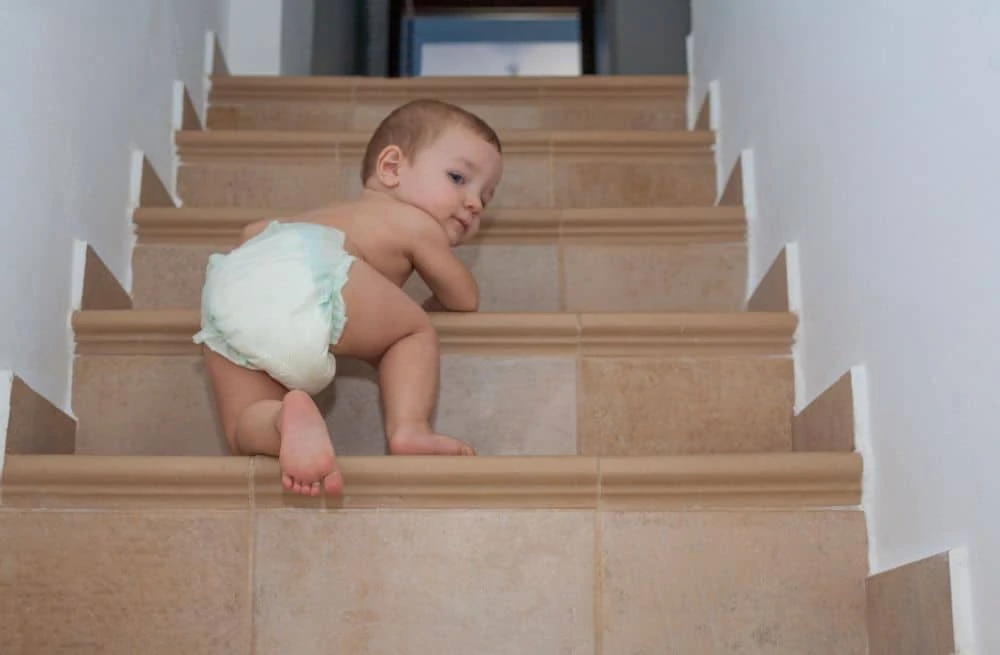
Stairs are a magnet for toddlers. About 8,000 children visit the ER daily due to falls. Proper stair safety is one of the most critical babyproofing steps you can take.
Follow these guidelines to prevent tumbles.
- Top of stairs rule: Always use a hardware-mounted gate at the top of the stairs. This gate screws into the wall and has no threshold bar to trip over. Never use a pressure-mounted gate here; a baby can push it over and fall down the stairs with it.
- Bottom of stairs rule: You can use a pressure-mounted gate at the bottom of the stairs. This discourages your baby from climbing up.
- No-drill options: If you are renting and cannot drill into banisters, look for gate installation kits that use clamps and wood slats to create a mounting surface without damaging the wood. Zip ties are generally not strong enough for safety gates.
- Teach safe climbing: When they are ready, teach your child to slide down the stairs on their bottom, feet first. This is safer than walking until they are coordinated enough to use the handrail.
- Add traction: Hardwood stairs are slippery in socks. Consider installing a runner or carpet treads to give your child (and you) better grip.
- Clear the clutter: Stairs are not storage shelves. Keep the steps free of laundry, toys, and books to prevent tripping hazards.
- Improve lighting: Ensure the stairway is well-lit. Install a nightlight nearby so you can see where you are stepping during those late-night diaper changes.
Baby Proofing Around the Home
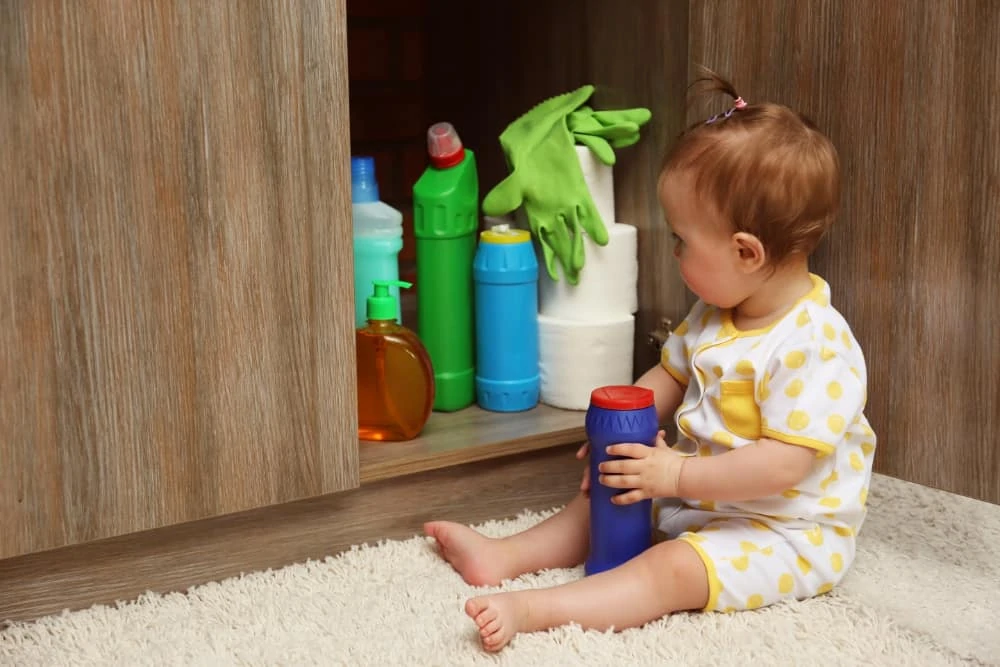
Hazards do not stop at the nursery door. From the laundry room to the backyard, here is a checklist for the rest of your property.
- Close doors: The easiest way to babyproof a guest room or office is to keep the door shut. Use doorknob covers or high locks to keep toddlers from wandering into rooms that aren’t child-safe.
- Lock up firearms: This is vital. Guns must be unloaded and locked in a biometric safe or gun vault. Ammunition should be stored separately. A child dies from a gun accident every other day in the U.S. (13).
- Secure laundry pods: Brightly colored laundry detergent pods look like candy or teething toys. If bitten, the concentrated detergent causes chemical burns and respiratory distress. Store them on a high shelf, not on top of the dryer.
- Watch the pet bowls: Dog food can be a choking hazard, and water bowls are a drowning risk for infants (who can drown in 1 inch of water). Pick up food and water when your baby is crawling around.
- Check your plants: Many common houseplants (like Philodendrons and Peace Lilies) are toxic if chewed. Move plants to high shelves or hang them from the ceiling.
- Vacuum frequently: A quick daily vacuum helps you find small choking hazards like coins, earrings, or game pieces before your baby does.
- Lock the liquor: Alcohol bottles are breakable and the contents are toxic to kids. Keep your liquor cabinet locked or move bottles to an unreachable shelf.
- Secure the pool: A pool is the biggest danger in a backyard. Install a four-sided isolation fence with a self-latching gate that separates the pool from the house and the yard.
- Cover hot tubs: Hot tubs must have hard, locking covers. They are a drowning risk and the high temperatures are dangerous for young children.
- Check doorstops: The little rubber caps on spring doorstops pop off easily and are choking hazards. Replace them with one-piece doorstops or use superglue to secure the caps.
- Inspect the deck: Check your deck for loose nails, splinters, or wobbly railings. Sand down rough spots to protect little crawling knees and feet.
- Install a fence: A privacy baby fence creates a safe containment zone for outdoor play, keeping your child away from the street and stray animals.
- Skip the trampoline: Trampolines are a leading cause of broken bones in children under 6 (14). If you must have one, ensure it has a safety net, padding, and enforce a strict “one jumper at a time” rule.
Baby Proofing FAQs
The Peace of Mind Is Worth It
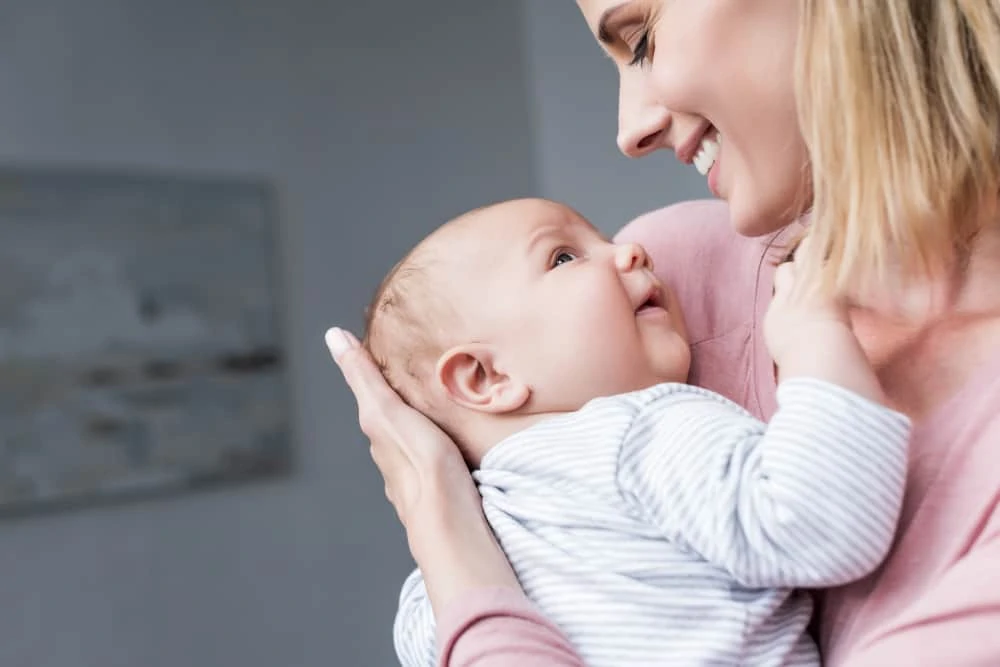
We cannot control everything, but we can make our homes safer. Babyproofing gives your child the freedom to explore and gives you the confidence to let them.
Remember, no lock or gate replaces supervision. Use this checklist to set up a safe environment, then enjoy watching your little one discover their world.
